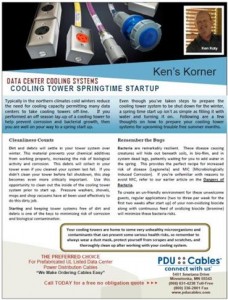KEN'S KORNER - Cooling Tower Spring Time Start-Up
Cooling Tower Spring Time Start-Up
Typically in the northern climates cold winters reduce the need for cooling capacity permitting many data centers to take cooling towers off-line. If you performed an off season lay-up of a cooling tower to help prevent corrosion and bacterial growth, then you are well on your way to a spring start up.
Even though you’ve taken steps to prepare the cooling tower system to be shut down for the winter, a spring time start up isn’t as simple as filling it with water and turning it on. Following are a few thoughts on how to prepare your cooling tower systems for upcoming trouble free summer months.
Cleanliness Counts
Dirt and debris will settle in your tower system over winter. This material prevents your chemical additives from working properly, increasing the risk of biological activity and corrosion. This debris will collect in your tower even if you cleaned your system last fall. If you didn't clean your tower before fall shutdown, this step becomes even more critically important. Use this opportunity to clean out the inside of the cooling tower system prior to start up. Pressure washers, shovels, mops and shop vacuums have all been used effectively to do this dirty job.
Your cooling towers are home to some very unhealthy microorganisms and contaminants that can present some serious health risks, so remember to always wear a dust mask, protect yourself from scrapes and scratches, and thoroughly clean up after working with your cooling system.
Starting and keeping tower systems free of dirt and debris is one of the keys to minimizing risk of corrosion and biological contamination.
Remember the Bugs
Bacteria are remarkably resilient. These disease causing creatures will hide out beneath soils, in bio-film, and in system dead legs, patiently waiting for you to add water in the spring. This provides the perfect recipe for increased risk of disease (Legionella) and MIC (Microbiologically Induced Corrosion). If you’re unfamiliar with reasons to avoid MIC, refer to our earlier article on the Dangers of Bacteria.
To create an un-friendly environment for these unwelcome guests, regular applications (two to three per week for the first two weeks after start up) of your non-oxidizing biocide along with continuous feed of oxidizing biocide (bromine) will minimize these bacteria risks.
Passivation of Tower Metal
Inhibitor chemistry minimizes risk of corrosion by creating a very thin barrier between your tower system metal and the water. This “mono-molecular” protective film is temporary and is rapidly degraded when the system is stored dry over winter.
It’s interesting to note that corrosion of tower metal normally is greater during periods of non-use. This is why lay-up/storage inhibitors should be considered when shutting tower systems down for the winter.
When starting up a system in spring, establishing proper chemistry immediately is critical. If you know your systems operating volume and proper feed rate of your corrosion inhibitor chemistry, quickly establishing your initial feed is easy. If you are not sure, contact your sales rep for assistance.
Example: If your normal inhibitor chemistry feed rate is 200 PPM, you will want to initially establish a 400 PPM residual to establish good corrosion protection. (Passivation) For this example, add about 52 oz. of your inhibitor for every 1000 gallons of system volume. This higher chemistry concentration should be maintained for 7 days before allowing chemistry residuals to come back down to normal.
Conclusion
You did everything correctly in the fall, now is the time to finish the job and get those cooling towers back on-line. Use this opportunity prior refilling the cooling towers to give them one last cleaning to address any possible corrosion or biological contamination. Cleaned and chemically treated cooling towers will perform better and be safer for everyone in and around the data center.
Ken Koty
P.S. I’d like to thank Steve Blumke and our friends at Fremont Industries, for their help in creating this article.

